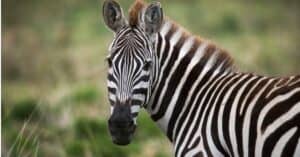Zebras are social animals. They live in herds, which may include 10 to 100 them. Zebras are preyed upon by lions, leopards, hyenas, wild dogs, African wild cats, and birds of prey. They have a great sense of hearing and smell, though, which helps them detect predators before getting too close.
Click The Link Below To Watch The Video:
Zebras are prey animals and tend to be quite skittish with animals that hunt them. But this zebra seems to have a natural death wish, as it keeps walking right into an ambush of crocodiles. Eventually, it escapes from the two crocodiles by getting aggressive and jumpy.
How Do Zebras Protect Themselves From Predators?

The stripes on zebras make it difficult for predators to see how fast it’s moving or how far away it is.
©GUDKOV ANDREY/Shutterstock.com
A zebra’s stripes make it difficult for a predator to get a good look at it. When a predator sees a zebra, it may see only part of its body at first. This can cause difficulty in judging how fast the animal is moving and how far away it is. The stripes also make it harder for the predator to determine precisely where the zebra’s head and legs are, making it more difficult to catch their prey.
Interestingly, zebra stripes are not similar. Instead, they are unique to each zebra and can be used for identification.
Zebras also have excellent hearing and sight, which helps them detect predators before they get too close. They can hear the footsteps of people or animals approaching from miles away and will run away before they come too close. They can also hear the calls of birds warning of danger nearby. If a bird flies overhead when there aren’t any humans or other animals around, zebras know that something terrible is coming their way, and they should run away quickly while they still have time.
Zebras are fast runners and can reach speeds of up to 50 miles per hour. This is because they have powerful hind legs. They also have an extra joint in their lower leg that allows them to lock their knees while running, so they don’t have to slow down when changing direction.
Additionally, zebras have tough hooves that help them run on all terrains, including sand and rocks, but they also use their hooves as weapons against predators or other animals who threaten them.
Zebras have layers of thick skin on their rumps, protecting them against lion bites. The hairs on the zebra’s rump are coarse. They irritate a lion’s mouth when it bites the zebra’s tail while trying to catch it. This makes it easier for zebras to escape from lions or other predators who try to catch them by biting their rumps.
Zebras tend to live in large herds, creating the illusion of safety in numbers with predators. What they don’t realize is that they are more vulnerable than when they are alone. A lion will select one herd member to kill, and the other zebras will run off in fear, leaving behind the chosen member.
The photo featured at the top of this post is © iStock.com/Cavan Images
Thank you for reading! Have some feedback for us? Contact the AZ Animals editorial team.






